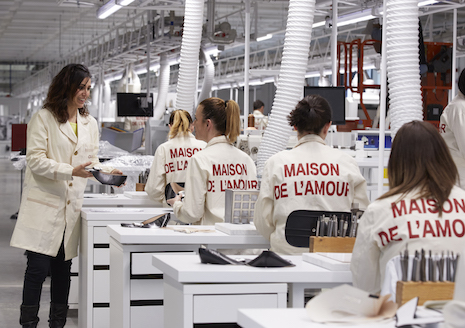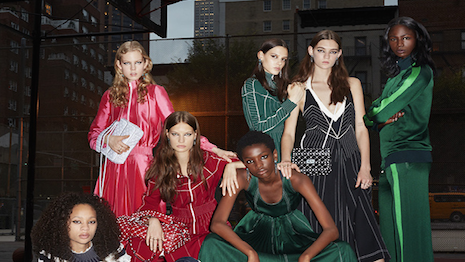Boosted by a rebound in China, the global luxury market is projected to grow between 6 to 8 percent this year, according to Bain.
The researcher’s “Luxury Study 2018 Spring Update,” presented in partnership with Altagamma, found that China will account for much of luxury’s growth this year, with sales in the market expected to rise between 20 and 22 percent. Due to the younger demographics of Chinese luxury buyers, these shoppers are pushing many of the business’ millennial-centric trends such as streetwear and digitization.
“2018 is off to a strong start,” said Claudia D’Arpizio, partner at Bain & Company and lead author of the study. “Currency fluctuations will have an impact, but we expect the healthy trend to continue across all regions and customer segments.
“Chinese consumers continue to stand out as a growth-driver for the industry, and are more fashion-savvy and digitally advanced than ever before, accelerating the shift of the industry to the millennial state of mind,” she said.
Looking up
In 2018, the luxury market is poised to grow to between 276 to 281 billion euros, or about $325 billion to $331 billion.
Much of the growth will come from Asia, particularly China. Japan is expected to rise 6 to 8 percent this year, while the rest of the region is expected to grow 9 to 11 percent.
Japanese cities saw increased tourist spending, while Hong Kong and Macau are improving. Geopolitical tensions in South Korea could hurt the luxury goods market there, as the nation relies on spending from Chinese tourists.

Shopper at DFS' T Galleria in Hong Kong. Image credit: DFS
Along with Asia, the Americas are also expected to see growth. In the U.S., a weaker dollar helped holiday sales, while tourists from Europe and Asia also boosted retail.
Overall, the North and South American region is anticipated to see its luxury goods market grow 3 to 5 percent this year.
While a weaker dollar helped propel U.S. sales, a strong euro dampened tourist spending in Europe. The region is expected to grow 2 to 4 percent in 2018.
Outside of the Americas, Asia and Europe, the luxury market will see up to 2 percent growth.
According to the report, growth is being driven not just by price increases but also by greater volumes.
Gucci is one example of a brand looking to ramp up its production. Earlier this year, the company opened a new almost 400,000-square-foot facility, dubbed Gucci ArtLab, that focuses on activities such as prototyping, experimentation and research and development. Demand for Gucci products has nearly doubled in the last three years, spurring the brand to invest in craftsmanship, innovation and infrastructure that will shorten its lead times (see story).

Gucci's ArtLab aims to shorten lead time for leather goods. Image credit: Gucci
Bain says that the global luxury goods market could reach 390 billion euros, or about $459 billion at current exchange, by 2025. The researcher predicts that luxury will grow between 4 to 5 percent each year through 2025.
Millennial mindset
Millennials are slated to represent half of the luxury market in approximately five years. As they become the dominant force in luxury, they are also prompting brands to adopt new styles and ways of doing business.
One of the key trends in luxury today is a move towards less formal attire, helping to drive sales of sneakers and streetwear.
Luxury shoppers are increasingly turning towards more casual styles for self-expression, according to a new report from the Boston Consulting Group and Altagamma.
Millennials are expected to represent half of the luxury market by 2024, and their fashion choices differ from previous generations, as they are more apt to mix high and low labels as they seek out clothing that fits their personal brand. Traditional luxury brands are responding through adaptation and collaboration (see story).
“Luxury brands should view themselves as the masters of their own destiny,” said Federica Levato, partner at Bain & Company and co-author of the report. “Customers are responding to targeted strategies, and top performing brands are already winning over the customers of tomorrow.”
{"ct":"SFxWS19HHJYx0+8d2l13waWFzo4QXh2\/xnOtnZwJkG72sjWzXqFQk9UPAPVM4Z4u8toNqJpr0NLIMEi53KqXHF8N0XlQJbJS86c9y6zAeHBB481zBxkPrLVhBYQCVa\/BPiiu3OhJXnlgKACM6klpBz\/1nCd9Rt3MBzVnpftp7KdaV9uzS3vyipezo0xijDotUMY5pkmA+NPq3\/YWzIdhY\/DnR\/GdQOsVRYyBTldYvu1RUl\/26ddr9Y5fFJCgDfC6YQQhrAnt6fcQL4cInlfpe+yuWIAMXMFh+cAxwrc2dl\/5kjY8VtExit33bd2fBAQ\/xNA0kb6vnFl5sBQ5k4OUl3BfZJUDn0NXAl7KsdzLybfybkDMybYDgtWC862OCRuPbIU2hLfm8J85wTmRdMnwCsPq\/7pPCJOTXSOmzHPmcLE\/E4upEjFWYICUQZQNCqSO2vKq6p8YLCuHOU9Ji4j7C8CK+0tGIhpHAYGzQ37LJehkGyvXaoFUx9dT3Ku+wmpoFCpTktL9Rig9fArLPMVD6bhpVfYeL6+Hl+ZMmTCA59qm9ICphxroV1kyNVSvy3mJSYj2jKExuyOwBMI\/fR7q6AgkNaCKh7JNInHPQ1By9ik+QdcOKDqDO04MvJX5e64bL1DagUDFm34nmHznqwecZOfh18IGQh4MbFWabmFkMUUQL1o+kVDexB7NVZtT3z00pU2mSIAnvQXQ6TMBvk3EJPjV93DK9shrcIEN2KxP4T7+iZjjtE\/INwcWbd\/wIe1k11\/bN2tdXJ98NBASv6GZTVl36VvEc0s7XjMiXkSIFDDvJkgaKfXE2Thq3Z5f9glDg9chaZPiNv8OsZlG2a\/7TqGePc0jrlWv9vgxLJuia5v7RpEMiODTY+XkkQBxZn33BNfQ0yaom757gIYJf3nnK9ODH0jYJwiSYThA7N91jgI2zZqQ8N91WXMXsHuy5B4d5tCtHGDhImbQyUHyaqzOQL4qxWgPLCdwgiqOLjdPFd8aPRtIMYYVSHglG73hM\/u2P0dz2l\/8RmKkAMxV+bVkllmcHsvf8dwN0N0JZ7rE24H1oH6tFFO6lyotoRynfWN0LlVqk+kVPGlQ6Oh1rXqxNwd763pRiJHfbG7vJUiWzZW4VmeY2lKS7WBER6A9oIlc7Nc6x6JxaLVJb7sRC7Gh1gMnF33KW3B5lKun+7xI7C2veF4+lepZteH2RUXaZPp0iIZHAdAaLzg49RFw6xm+\/7nXybPXeTIEDtTx7mBo5YXJRIi42Uv5U4iNF+Ae9RszT6HT6ClpuEtkHgcc4cZUiznMoqXdN7FWhcm9TH5MVUHbV6UlgnsmzCLuT7VFcotz0pbTj29+VoVnyiQCq84993HROQ07lwB3bQph73yZM2YesmXnbDpmaojTtsKGpr8g25X7F3jpATJuKUP3JYhI27Bu7S5LK9mw5c5EvAEP\/3zyRBfma\/We8IlH0B6\/V6paFUadkiNrIFvOmbXoiXYWKjrIUjU7oVgAjTI\/YauK\/Ul\/jTl2V9Ply2WMdFAETxK2Ev7b5M3imVw2Xyk+FqmN2F1NwoozaE1XbuahSj5\/VJCT+w1GGcpET0AMCqStf9Msg188NpxkGDGE8p0INUaUmJjvf\/1PJDFXhjb9y2+Hm8l0AHoYAovVFYqjXEQZ04GF6kD9B+y4GTxIDsSG7WJ7Gxqle1RDonsBfhTnRLTHjO9\/M+00+zAHVndUyM3s+ecPZp6A3\/qg5zp1ZB6WxHN6ITNzC1CwS+sxwBPjoX0RcLuinSc5e+uGbNhrWzzYQG\/tSAG3jGRfrPQ0VUO7IaF6OGnaeNS9FUngrBgsE4sFaTofjngGPa\/9h3GlDIY4kcsAl3uAlnADaPn4qyH0fEYm0qdg0x6fiYuEvYcx7s9fm+nIxtRz\/CVErhzO\/deomi175BZQNcqX9TYIddrtTN93VPJPqV831Mxbex7jy2x9xpqGMQK4j6a1dj80VeFBN\/y3K0IbSM1uK1VceKr5Y7m0IZF7fPzV3rYdwTiZqquMcclRtdkpaS1N32Mz6UmVsSeQzgU\/qoBfLTXSNaZ+XIa8vd8j7QYufY8P4hcjh+dwTLxfP28UMK1MpVZzYf5WHRSzDLtMoE6KdGP8g2BCHhoVZQt4DbLf7HJNR8ODaT6LJz7nkI27\/uoXqcsvg4BKHfO40Yt1c8RuZmBpwtCGg3dCiQ\/mBAcm47w4i2krQDWk36QssTPrX2se8W\/L5M2Cf0guAqeIjtZWUAUfehPgyVYQJqPJbt1I13kp3jJMr8+0Ex+ZfUFPmDgnlmo9k6c4ghnmFO5nZvY+l6ses+SQH4LuDZ07w+rmqYVg1SmK8VPP9j6ia1oZ9+VmZc4JSEM990eB0NCYGz9DZZu1N65dNHwnhyQssySEEFtkqXkfU3yUw0cTTR+Wev4MyLSgx99eFV\/+\/2sSurSXgCTPgW6XG6dchjaokXY6N6+U3gAFR4rpz+r+ku7oLmCY++xElWuhO2EGRFtAl2\/U982bWvNj2\/qK+E9b7VWMiTiDZ+YnuV1g5paBztTNPRbbaxYJQw9PhGsKdMS+7VR\/E\/FOhZg0sEuw1+OysFNNgTT+odHU10X1wsMwfBB6+i+x9ZrrNIoNyc2TN8W4yj9cAz6ftJm9d3mBgjimomnrHYStXr4tuv1S+yUEr1aB4FJV60GJ4V2InjX\/nVt4EjRlU1M0SAbHi8LN9IGigYMGQEXLrXyO6YzdjIUM72qugagpWJGVD8DiMSB15PxamV1cH1gwTbJ\/Uecl7XE1C2uIy2XzUKKXWd3sQiWTeJLgB0plVDhgBMK+IkBw0GnFmUKCeYoUqjHQbmUvDsCvQrgInMT72gGrBMO0hNJgwtdBSIw2EP5+mmT+O8paxhcDI52RjRki8spTNfZbOwVT0RDiH5hvWCFwb3O3CqZvJrX0d0pszbpqXvXHUR1MQAqtm0VyrVPIUiM5\/plALmLLacaPVOG0Qo9B3lnWeak2aF\/kuG16LGnish2y420+NyB89HKNPFFp0rU8ZUEydIckfVpkK7pLY21ntzgrsiaRBOdFbECAXUbKmV+UbFJXsxhrnr5jj8kmcCOhL6NW0SsR8slfoZvXiPv7ETlY37KTKqRkR5IIGzBV2Jvqgo6JLgZXUizfpx7APiaavVtw9IJ7dLGE0CUaHEKeLfFZpQCoIVQxVFI8krBGJQmNjk3bRB+D3lwGJpPjpdAHJZdC802lzq7J5+CGYmDyc5pH2jhDhEdvc7tc0Tw83W9qPk50Chk5cqn8ZX\/wW2iu0yj2noap\/UpT1zfkMinThGl4WU8C7skKAR1RYnEWoKfp6OCc3NjQrdFpb4nk2uRe3hq2iUbiUKlW99Ba5nFq0Usv9tP07iFO4q8s+VQncK1o14RGdjIgakLAoT+3V7zRP0VSFppm7NmFsM+tsI3XEm21tvUXew59kwaPe3oKdB070XOKO7xF5Kf0TAFbbazgJE67EjxMvQunFV82ffAyrRbnDizFoVbBPMkAetvBjmsngXOCmV3bOSkk42KFs6f9E4XG4IVyOFgSFTpaEDnJ4aJlaVGR11srbhZs7vr3UeqkiD26Khtqg\/8qRlXTeHQnmS8D\/Gg5UVl9jd25vHc7wpIP5O3LIeBQ0X4upy\/4fj3pIR7hh+sB5slJaYF2OjEYK4OnVkKDQw81c4lw\/dxy3ZGX89eaxrsqmemOrGSpVtEKOiwkRVx6mqJ62ktziDQmG3oRYcZ+bYG\/vipl3xPPDKfb1gnDAcmoIWCxYn6x9p2DDx2Qj6+6pJZSIUMYU5DgUieTdnXG2WMXp4U+v2Li7IVqS9eassrJ5J16D\/POtNiKlw7birmN0bNR2lIa0reDNhBSPhYCPFLGVl1a35a10Ui2vSMDUEHdAbYgLKrXdt6vTsw5b6sBpYuOAs47wkQCDxuU4OfToUEJ1XvOV9EAFhDDoPzrhWjtNywAMBhPqxAMIgxsit21hm859\/SDozlDB9fIG+4iyBy6E3j3fF6rLrt+wuWACGLUxJN9+WG1\/BTFB4SaSMST4MzHNbwfVSgUmFmxpnEQLh8wn6DbxzycB2+Ga53Mw6EDtwTafWZmvyqTQ017OM1F\/84KSxQRBc1KqvG8E363HR5DwfrOEJPjWBmcASxPgEumx31xodsIrizOE2qtdBXYFY65x\/6AEHGl3uwJe94oJh9DnzCtUtU3fYz2\/bK7RBGd2H+qu2aWPS7fhf9mSQp9SGn2zgsjbk1+EGm4VyBkygOszlpCpVtbUlrzYi+2PLSwPtEGal429rOtDCFufkG7Sm3NpCswmeQPWpcQ6QUYUdTH63NXxiOW0if\/6rlBcqELlQ0JAO0wOSgA\/RIh3tRs+sYLoYiZFiwrMtCaDzhnVwWxGxGFwY1BvaFXSNwcLOLULtiGXEfOlE9Oy4IeEdWMS2U3R1Ssn2ZKC55Y1T2G2OB9NDg6CNia4noU4\/kv9ADeQ2ebM5wNsctJ9nXcliSiDqv\/Ex2cGUAYtYQ0WPXR0hv2UR5cl7MVzTe9w7gwuDNgzZGqo7ZKfTkqG\/tIKB8f6QfeteVH0fbNebMXjJHhaZTrpuzAMsIBRSp2\/5yXN6VrcEX2Pp\/FkT3JDmna6yYW61H99EkW2F0oLhucjbJsiSUbxhmAcv7mD6UQQHwpgmk88y0dIxhRnUpYV7a4lMoMHoSJ++HX0Bpz\/eM8KsoWkNNzXVEE1ZUIASZETJVmJ2vjwea3ANYFfE8POA6zkyy8ujKjDWBSMWHYugv7Nvn9An2stg2W\/aGTZa97UfCyoYG+dg66mhHRPmRV\/abrgbG64vUhFKGE+giTgIxw+N2kp7tMMvN0dE30RSPau26JNE4jgT\/3HiND4gPQIKZGYje+nrEUjaaHqpN89vgdXcx9hyIUN2806SVlErG3j82jfgdZeIinEhU1YqlPVsJ2wvgqLvhaeoTXBoWL6WWQalgOUKypGvgX9yRLreIAa4KIKh1+DIU\/KPxffn1SkG4B7ZVcKjxCMwRb7jwSYF\/89CGl4ZxNWCxOzbrKIKqcvn5nwqx73Gf6wh7yp740XhWQcxSp8U7tCsNRO06URUPg5kkgLpCtBKFDFQ5xOEsqdxNxQC9xy7nJt13UjK5mw3WZg9U25I3aQHkJsWq+HLF7noTYXDhMap2Zua7eLBmEWzHasocAwCxcZ6tYlwC\/izwOmmtm67y6lMhDI27E1SDLngvt1nIyrktyMmw58ZGryYb00+LKsKxnkDtwN4\/jKzpEQ3fqgdSxHIEpCqNJ8i6oCGlbiaBqN5cEla3tJiyGNKsvam2Q4r1dDZV0\/a5w6p01A7ob\/s2r5uDP0QhgJGKFYHABmsxA5G11vJeXOlMh0zap1Sq0hFtBP8b5F1cRleeoq3cGXGKFrfa8lk2wyB8EA3DYeEdK6B7gWsmsB4iEk\/a793x8rVHElkzUkrXCHd\/zFGVKiGh6hpLc5835MjBLl6yVECJpB3B4abIImlhlxxRz2gvj5uvxsjZWs3XO4pvMhjAG5Ft+\/uR5CXDcLFJuQgTpkPNtZOzvy4DoYyBJVMfuGL8i899U3lTh4qtmvnYA1287Wf+yZ66eTtqVL0xshYhBpKTf+XAAPscaBcOZhUf4g9Y7GR5aNx8YEaONRXJgw8rci\/+xtjoHc8hueE2zehWoeH7bA450+Q7XpPc3PeE3fMcnGdPOsqVJViMkRMhj26\/mqZ2hBX66QVVZfP5m3tddEG59KnekMlKP842o6TFjse3vGlDbFRyQ5SyfKqx8EVkEoOsS6rqP2Tdy5PvNJ9v6kOMq6Zic2520mvMzFN02kpyI75z\/6sgzik9JKyQUv+iJkoKsOOPAZ2OiaLazjPdHBAtPj6Iv9jI\/NW3YJVI7tq3t6HM1XE1nxQr4MYIbMFIElmKvz8E0scYqehjhnzRe+c+cPmqd1n0Tp7rx9YzxlsGMzXjcDNo1F28l4E464vw0aKHsnxZ45OzJ8FrsraRHKmR8FrClglvVsNf84g8RNf5EvDHesy4Ay3F3jgSgETrqUP9fUuPfPi3W4xljwXI5Zuv\/fwaGwL+BeKDkmaij6Gz8TZMcHY+jocUZQIdcILAXKYKGEoQsqiYUd9zhGqhARgqzleTr7mRNF932MfIoty4LerqDVd6VmY5qBRfNeEWpUAWZUGDgXfCEy3V\/Qgu5Cv9pFjtRsQbk+ZjDkzPHe0UT6bwWUg4N\/+yJ+M8Tmye7TkZBPpzQ7P6JAP5De9Yzjwzea0U36zov9LqQSKZXSdknpdqulSnEyyfDKaZQJWGToLmqxz+LxdZmMuM5v7y7TtPsILHPJs3wEjBjqSSQlDMFUOhOhTW2ETJdpI32deMk1EIWbTCE2yEpgmPc5Y02hImE02mKq1sLTXVPvSb0gLnNiH3giXcm9WdmplDPqRK45FYCQ5pcgLwlV4EhDokiauXD2ES5CqJRiH95BcF8BN5xrmKpU9tWMaoy8UST\/WoLr5rbT\/meaRBUnSHwWT8GOdU7MAac5hQevZyh1Y6PW45PR9GdXSAYMLTMHd5R1G7ndsLUhdAf4NtraEanKbl9lP+Z5aWfJvJlRthxWfuFs1WRysi230jcWoTgApPRX1RQrtaibopkkOcSb8gKhLRq+vP1HaSzCryG04KPC7IFAtZyNqTlaWf1n3HEbs+S0mpo5YXg+06uppaqCgvtObF6TQMrLAsOgM0vprhZEnLiLw28MzLyZ+17WcjhY1mIutX2JYEd+InDmlW\/o5p4oV6xjPy0uBF5vaFmhnoB\/neA2uMxCZj7qjvAcjyt+CC8AU9bSuckyn0HU6v42VCoDs+TRKxSoPEeQFOSQQ1DopXh9jcckzOJK1wuzICIJIRDncax4s1skhUWD2xZtpFg\/G6CgvAk849COVWB6CwZ9X\/MkwHfPzhMfNJQVNjiSvb+rxNgXLSvGpTdcHkbHybe8Bfy5RBfSpVfls8gLiEZhlaGUV8KehKtXLVY0mr48AnMhXA17InlXcqbFbuZko2HTt1+ajPeGt02c10Fd26\/30KBoTUs4VU21+do2prj6l2aE+LJ4\/zXpN\/o3QCUz\/w6OVeQmzWzJQ+\/\/HYuFHSBdFe1CkNz\/opO2G4PeBg5P9IK3IHub0E9kAPtWJ6QWOzNl+3piNTsmQ4DU5jMavRR6052cFxlYLFWzGuDFA7xca0HAH7IUVWl5RkYgt9f7ZVrtqbKDo9BEjBvAt+YmiKY1jvP8SpvkuLOibH78iiKkiOueqE\/RW9ypDFQXPNZgLhAQQ==","iv":"9ae41ed656b6418b6b32a1311018ef9f","s":"b1467144cd93edb5"}

 Streetwear and casualization are key trends in luxury today. Image credit: Valentino
Streetwear and casualization are key trends in luxury today. Image credit: Valentino